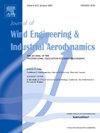3D ultrasonic anemometer array reveals jet flow structures at the entrance of high-speed railway tunnel
IF 4.2
2区 工程技术
Q1 ENGINEERING, CIVIL
Journal of Wind Engineering and Industrial Aerodynamics
Pub Date : 2025-02-01
DOI:10.1016/j.jweia.2024.106004
引用次数: 0
Abstract
High-speed trains (HSTs), traveling at speeds of up to 300 km/h, are subjected to safety risks in crosswind conditions, particularly when they enter or exit tunnels due to transient aerodynamic effects. The study employs a three-dimensional (3D) ultrasonic anemometer array positioned at the tunnel entrance to investigate the jet flow structure and its 3D characteristics that are induced by HSTs as they enter tunnels. The main results are as follows: The jet flow speed reaches approximately 3%–7% of the train's operational speed, with a maximum length of around 0.48 L. When the train speed is increased from 300 km/h to 400 km/h, the effect of its slipstream on the surrounding wind speed increases by 33% upon entering the tunnel, while in the jet flow section, the wind speeds from both sources are comparable. Through field measurement and numerical simulation, this study provides better understanding of the characteristics of the 3D jet flow structure generated from HSTs entering tunnels, thus offering more insight in developing means for reducing jet flows.
三维超声风速仪阵列揭示高速铁路隧道入口射流结构
高速列车(HSTs)的运行速度高达300公里/小时,在侧风条件下面临安全风险,特别是当它们进入或离开隧道时,由于瞬态空气动力学效应。本研究采用安装在隧道入口的三维超声风速仪阵列,研究了高温射流进入隧道时引起的射流结构及其三维特征。主要结果如下:射流速度约为列车运行速度的3% ~ 7%,最大长度约为0.48 L.当列车速度从300 km/h增加到400 km/h时,其滑流对进入隧道后周围风速的影响增加了33%,而在射流段,两种来源的风速相当。本研究通过现场实测和数值模拟,更好地了解高温射流进入隧道后产生的三维射流结构特征,从而为开发减少射流的手段提供更多见解。
本文章由计算机程序翻译,如有差异,请以英文原文为准。
求助全文
约1分钟内获得全文
求助全文
来源期刊
CiteScore
8.90
自引率
22.90%
发文量
306
审稿时长
4.4 months
期刊介绍:
The objective of the journal is to provide a means for the publication and interchange of information, on an international basis, on all those aspects of wind engineering that are included in the activities of the International Association for Wind Engineering http://www.iawe.org/. These are: social and economic impact of wind effects; wind characteristics and structure, local wind environments, wind loads and structural response, diffusion, pollutant dispersion and matter transport, wind effects on building heat loss and ventilation, wind effects on transport systems, aerodynamic aspects of wind energy generation, and codification of wind effects.
Papers on these subjects describing full-scale measurements, wind-tunnel simulation studies, computational or theoretical methods are published, as well as papers dealing with the development of techniques and apparatus for wind engineering experiments.

 求助内容:
求助内容: 应助结果提醒方式:
应助结果提醒方式:


